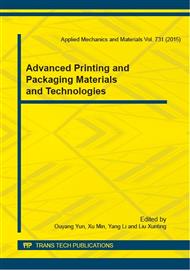p.430
p.437
p.441
p.447
p.452
p.457
p.462
p.466
p.471
Research and Application of Retention Agent in Reversible Thermochromism Materials Papermaking
Abstract:
This paper discusses the effects of different retention agent such as: CPAM, APAM, PAE+CPAM, cationic starch with high degree of substitution and modified starch on the reversible thermochromism materials in anti-counterfeiting paper retention rate, and then determined the optimum dosage of retention agent in the slurry. According to the anti-counterfeit paper color value, the mechanism of reversible thermochromism paper was studied. The experimental results show that when the slurry with retention agent, the reversible thermochromism materials in the anti-counterfeit paper retention increased significantly. This suggests that retention agent in pulp fiber has played the role of bridge and link, thus ensuring the security of reversible thermochromism paper.
Info:
Periodical:
Pages:
452-456
Citation:
Online since:
January 2015
Authors:
Price:
Сopyright:
© 2015 Trans Tech Publications Ltd. All Rights Reserved
Share:
Citation:


